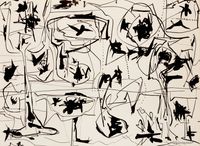Best known today as a sculptor, Wilfrid Zogbaum began his art career as a modernist painter. He was the son of an admiral and the grandson of Rufus Fairchild Zogbaum, an artist-illustrator who covered the Spanish-American War. As a child, Zogbaum traveled extensively in Europe, and spoke French and German fluently. In high school, he spent two summers studying painting and drawing at the Rhode Island School of Design. In 1933 he enrolled for a year at the Yale School of Art, but left to go to New York where he studied initially with John Sloan. Beginning in 1935, Zogbaum attended Hans Hofmann's school, where, with Giorgio Cavallon and George McNeil, he served as a class monitor.
Read MoreZogbaum described Hofmann as "the only prophet of modern art in America." He believed, with Hofmann, in the importance of nature within art: " ... when art gets too far away from nature or from ordinary things it begins to lose itself in a kind of ... glorious mist."(1) Some of Zogbaum's paintings from this time, such as the 1936 Untitled Abstraction, evoke the colour of the Provincetown landscape where Hofmann had a summer school. However, in the Untitled Abstraction (ca. 1934–39), the visual connection with nature is more elusive, based perhaps on the unseen structures of the world.
By 1937, when Zogbaum won a Guggenheim Fellowship to Europe, he was already a member of the American Abstract Artists. The trip to Europe, though, proved significant. Zogbaum met Ben Nicholson, Naum Gabo, and Laszlo Moholy-Nagy in London. In Paris he met Wassily Kandinsky and developed a close friendship with Fernand Léger, a relationship that continued after the Frenchman fled to New York to escape the war. But Zogbaum spent most of his fellowship year in Bavaria, where he associated with Fritz Winter and other former Bauhaus teachers. Returning to New York, Zogbaum painted independently for two years. In 1942, he joined the U.S. Army Signal Corps as a photographer and was with the first U.S. troops to liberate the Pacific islands.
During the late 1940s, Zogbaum became a successful commercial photographer in New York. But in 1948 he left this career to devote himself full time to his art. He exhibited frequently during the 1950s in group and solo exhibitions, and became well known as an Abstract. During the mid 1950s, he began making sculpture, initially as a supplement to his painting, and for several years divided his time between the two media.(2) By the late 1950s, however, a decision to temporarily stop painting became a permanent choice. Given his love for nature, it is not surprising that many of his early sculptures are animals and figures. These were often made of discarded machine parts and other found objects, whose identities became submerged within a total statement:
Most of my sculpture has been made with the methods and materials at hand. One of these is the beach-stone which seemed a means of introducing a solid volume into the open cage-like structure of steel. At first it was used as a head-like part in a somewhat human or animal image. Later in a more abstract sense and in counterpoise with other objects within the image in a variety of meanings.(3)
In 1957 Zogbaum taught for a semester at the University of California at Berkeley. This position was followed by short-term teaching posts at the University of Minnesota, Southern Illinois University, and at Pratt Institute in New York, and a return year at Berkeley in 1961–62.
Virginia M. Mecklenburg The Patricia and Phillip Frost Collection: American Abstraction 1930–1945 (Washington, D.C.: Smithsonian Institution Press for the National Museum of American Art, 1989)
Courtesy Smithsonian American Art Museum




